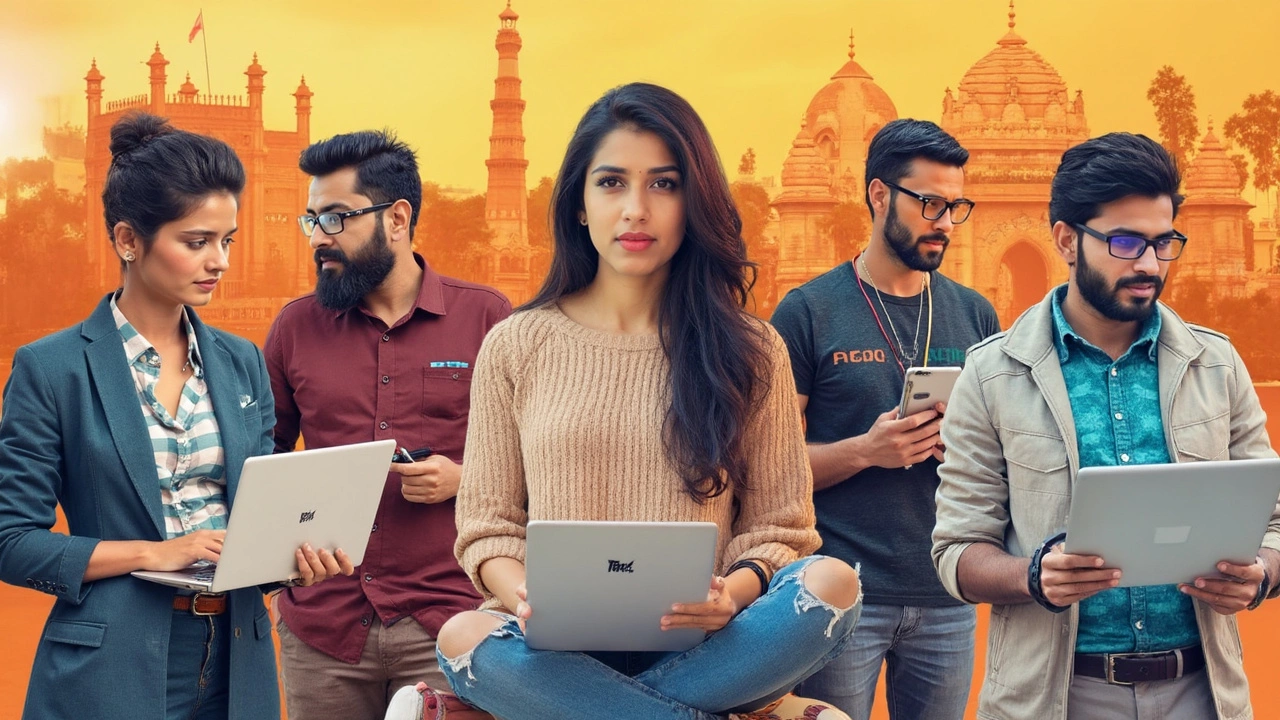It's wild what a single blog post can do. You read something that clicks, sparks a thought, and—just like that—you’re hooked. That punchy digital voice might belong to someone you’ve never met, or it could be an internet legend with a cult following. But here’s the big question that splits dinner tables, Reddit forums, and coffee shop chats across India: who’s the best blogger in the country? It’s not just about follower counts or viral hits. The answer is tangled up in personality, grit, creativity, and—yep—pure digital magic.
India’s Blogging Scene: A Heavyweight Arena
Blogging in India is anything but a small-time gig. The country is flooded with over 80 million active internet users reading blogs in Hindi, English, Tamil, Bengali, Malayalam, and so many more languages. There’s a real hunger for authentic voices, no matter the topic—tech reviews, fashion, street food hunts, political deep-dives, or relatable stories about growing up in a city like Lucknow or Chennai. Everyone’s searching for that one blogger who gets them. It's relentless, and a little chaotic, in the best way.
Every year, the blogging community gets a handful of new faces who seem to explode out of nowhere. They might start with a basic WordPress site, shooting food photos from an old iPhone. A year later, they're grabbing sponsorships from global brands. The ones who stick around? They work like maniacs. Leading Indian bloggers post at insane schedules, often putting up fresh content every three days or less. The new kingpins invest in high-def gear, clever editing, regular newsletters, collabs, and an active social presence. If you’re on X (Twitter) or Instagram, you already know these names. Think of the likes of Amit Agarwal, Harsh Agrawal, Shradha Sharma, and Malini Agarwal—their influence stretches far beyond Indian laptops and smartphones. And you’d be surprised at how much they shape opinions. There’s data to back this up too; a 2024 Statista survey showed 72% of urban Indian youth trusted bloggers’ recommendations more than traditional adverts.
But there’s no strict answer to “who’s the best” because different readers want wildly different things. Some want SEO hacks from Harsh Agrawal (ShoutMeLoud); others want inspiring startup journeys like those on YourStory by Shradha Sharma. And then there’s Malini Agarwal’s MissMalini, loved for celebrity scoops and lifestyle trends. Are these guys the best? Well, that depends on whether you care more about life hacks, business stories, or Bollywood drama.
What Makes a Blogger ‘The Best’ in India?
It isn’t just about page views, though numbers do matter—a lot. But when you look closer, the best Indian bloggers share something else. They’ve got a wicked blend of voice, trust, and a sixth sense for what their readers will crave next. If they post a guide on earning online, it’s packed with screenshots, earnings proof, and real examples. If it’s a travel blog, you get punchy descriptions of that chai stall in Manali plus the bus schedule in the comments. No fluff. No copy-paste. That’s how best Indian blogger status gets built.
The authenticity factor is huge. In India, readers are sharp. They know when you’ve sold out to a brand, or if you’re just pumping out posts for clicks. The best ones don’t sugarcoat—they’ll review a smartphone and point out its bugs, even if the manufacturer sent them a free review unit. That’s gutsy. Credibility is the backbone. The likes of Amit Agarwal (Labnol) built trust by offering step-by-step tech solutions years before YouTube how-to videos took over. His guides on Google Sheets and Gmail are practically canon for coders and teachers. Same goes for techie and SEO-focused creators like Anil Agarwal (BloggersPassion), who breaks down affiliate marketing with every pitfall and workaround included.
Community engagement is another non-negotiable. Top Indian bloggers respond to every comment, host Q&A sessions, and run Telegram groups. They learn what’s bothering their readers, fix their mistakes, and crowdsource future ideas. YourStory, for example, gets pitched by hundreds of young entrepreneurs each month hoping Shradha Sharma’s platform will spotlight their projects. That’s not luck, that’s earned trust.
Then there’s consistency. Anyone can have a viral hit. But the best Indian bloggers post rain or shine, pandemic or not, from hotel rooms, trains, and sometimes during power cuts. Readers stick around because they know what to expect—a new story, a sharp opinion, or a life hack that actually works.

Who Actually Leads the Pack? Digging into the Big Names
A few names almost always crop up when you ask, “Who’s India’s most influential blogger?” Here’s a closer look:
- Amit Agarwal (Labnol.org): This is the OG of Indian blogging. He quit his corporate job in the mid-2000s to launch one of the country’s first professional blogs. Unlike flashy vloggers, Amit keeps it crisp—detailed tech tutorials, workflow automations, demystifying new tools, and quality guides that have helped millions navigate the digital jungle. Ask anyone in India’s IT circles; Labnol is legendary.
- Harsh Agrawal (ShoutMeLoud): When Harsh started blogging in 2008, hardly anyone in India believed you could earn a living from a website. He battled a near-fatal accident and kept publishing—SEO tips, blogging advice, affiliate marketing—until he actually proved them wrong. He gives away keyword blueprints, real-life traffic stats, and answers embarrassing beginner questions without snark. That's why so many new Indian bloggers list ShoutMeLoud as their blueprint.
- Shradha Sharma (YourStory): If you’re into startups, YourStory is practically the homepage now. Shradha built a powerhouse for founder stories—especially those outside the big cities. She puts small entrepreneurs, social change-makers, and first-time founders on the map. Her coverage has nudged investors to take notice of bootstrapped companies, especially after Covid made entrepreneurship the new cool.
- Malini Agarwal (MissMalini): Not everyone wants tech or business advice. MissMalini is ground zero for Bollywood drama, fashion inspiration, and fresh gossip. She’s crossed over from blogging to running a media company. Gen Z and millennials worship her posts about beauty trends, influencer interviews, and party looks. Despite the glitz, there’s a storytelling spark most clickbait blogs can’t pull off.
- Anil Agarwal (BloggersPassion): The go-to for anyone serious about making money online. He’s no nonsense—genuine analytics screenshots, earnings breakdowns, and detailed case studies. Anil is particularly famous for myth-busting—he will tell you not to buy thousand-dollar tools if free ones do the job.
Of course, there are many regional and niche bloggers—foodies like Nandita Iyer (Saffron Trail), travel junkies like Sankara Subramanian C (Be On The Road), or mavericks like Seema Misra (Momsmethods). Some have a few thousand loyal fans, others millions. But the common factor? They’re all real, relentless, and obsessed with giving value.
Tips for Aspiring Indian Bloggers: How the Best Stand Out
The Indian blog scene is fierce, but it’s not closed off. If you want to be the “best Indian blogger” next year, or just carve out your own digital tribe, maybe these tips from true Indian blogging stars will set you on the right path:
- Know Your Niche Deeply: The broad “lifestyle” blog era is long gone. The best success stories come from creators who dig deep—into Law, K-pop, eco-travel, Kannada poetry, or local politics. Pick your obsession, then go ten layers deeper. Readers can smell authority, and they reward it.
- Pace Yourself, Write Often: Consistency wins. Amit Agarwal once shared he’s written a guide every week for years. Not every post will be a hit, but every post sharpens your skill—and grows your archive for search engines. Posting regularly is the #1 advice new and old bloggers agree on.
- Focus on Usefulness: Forget flowery intros and empty stories. Your reader’s time is limited. Get them in, deliver value (tips, lists, personal hacks), and don’t pad out your posts unnecessarily. Add screenshots, examples, templates, or downloadable cheatsheets. The best bloggers always leave their audience a little better informed than when they arrived.
- Master SEO Without Obsession: Harsh Agrawal jokes that writing for readers comes first, but smart SEO is a lifelong friendship. Do basic keyword research, optimize headlines, but don’t let it kill your voice. Google likes clarity—and so do humans.
- Build a Conversation, Not a Monologue: Blogs may start as diaries, but the stars reply to comments, ask questions, and crowdsource new topics. On ShoutMeLoud, community questions drive future posts. MissMalini built a strong IG Live series just to chat directly with regular readers. The more interaction, the closer you get to real influence.
- Stay Open About Monetization: When you do a paid post or affiliate review, be honest. Most Indian readers respect transparency—even about sponsored placements—over secrecy.
- Never Fake the Data: Founders like Shradha Sharma have grown reputations by sharing success stories complete with real revenue, struggles, and losses. To stand out, back up your claims. Don’t Photoshop earnings screenshots or invent stats; someone will catch you, and trust is gone for good.
- Mix It Up: Experiment with video, podcasts, or carousels. In 2025, blogs aren’t just text—they’re YouTube explainers, Instagram stories, and bite-sized newsletters. Look at how Anil Agarwal cross-posts content in regional Indian languages to reach fresh readers.
- Prepare to Invest in Learning: Read (and watch!) the best in your field. Subscribe to international newsletters, take online courses, and keep tabs on algorithm changes that affect Indian blogs. The leading bloggers aren’t stagnant—they’re up-skilling constantly.
- Understand Your Audience’s Real Problems: Whether your crowd is students, hustlers, or home cooks, get obsessed with their daily headaches. Solve those in practical, creative ways—and don’t be afraid to ask for feedback. Some genius Indian blogs started because their creators couldn’t find useful answers online.
The rules keep shifting. Algorithms update, audiences migrate from Facebook to WhatsApp groups overnight, new platforms pop up. But if you want to last longer than a hashtag trend, you have to adapt—and prove you’re in this for real connection, not just a quick buck.
One last thing: don’t get paralyzed by who’s “the best.” Numbers matter a lot less than you think. Bloggers like Amit Agarwal and Shradha Sharma focus on reader problems, stay brutally honest, and keep their work fresh. That’s why their impact outlasts fads. Indian blogging thrives on sharp point-of-view, relentless consistency, and relatable storytelling. Copy that formula, add your own spark, and you’ve got a shot at the crown—whether your audience is 500 or 5 million strong.
